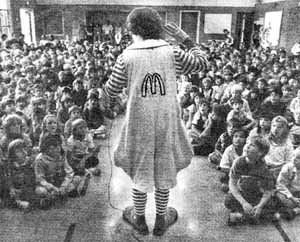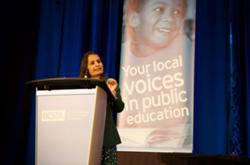
Corporations are heading back to school, armed with sponsorship deals and merchandising opportunities. In Surrey, there’s the Bell Performing Arts Centre, the auditorium for Sullivan Heights’ Secondary, with its BMO/Bank of Montreal Balcony, and RBC sound system. Over in Coquitlam, Burger King, Pizza Hut and Subway serve up kids’ lunches in the cafeteria. And in schools throughout the province, Scholastic Book fairs are held to fatten up shrinking accounts.
A growing chorus of researchers, however, caution that the corporate presence in schools is associated with long-term damage of children’s educational, psychological and physical well-being.
These critics contend that corporate money is a quid pro quo, intended to capture the allegiance of thousands of potential customers, most of them too young to own a credit card, but not too young to be branded for life.
‘Everything is for sale’
Corporations portray their presence in the schools as benevolent. In the words of the BMO/Bank of Montreal, corporate largesse is given “to ensure that Canada's regions, towns and communities remain strong and vibrant.” School board policies around the province characterize education-business partnerships as a carefully monitored “win-win” situation, that does not allow commerce to exploit students. A typical example is the one adopted three years ago by Surrey: “The Board encourages corporate and community sponsorship as a means of enhancing learning opportunities for children and building citizenship in our communities.”
Doors that remained closed to corporations are being cracked open by tight budgets. Some districts now raise as much as 16 percent of their budgets through “local fee-generation,” the euphemism for money raised through business arrangements of various sorts rather than taxes. Cheryl Quinton, spokeswoman for the Coquitlam School Board observes that commercial relationships are “a help,” because “obviously there are some parts of education that are not being funded as liberally as they were some years ago.” Turning to the private sector to keep schools afloat has been tried by chronically under-funded American public schools. Susan Linn, who teaches psychiatry at Harvard Medical School, has studied how these public-private relationships affect children’s well-being. She says relentless exposure to all kinds of marketing messages—from the Coke logo on a gymnasium scoreboard to the promotional literature for Scholastic books—inculcates materialistic values in children. “What children are learning is that everything is for sale,” she says. “They’re immersed in a culture of materialism and adopt the value that things can make them happy. And what researchers are finding is that that’s not true.”
Learning about happiness
Tim Kasser, a psychology professor at Knox College in Illinois, is one of these researchers. Kasser and others have surveyed hundreds of American students, most of them 12 years old and up, with a set of questions aimed at establishing the student’s primary values. Students are asked to agree or disagree with statements such as: "I'd be happier if I could afford to buy more things" and are asked to choose, for example, whether the purpose of life is to be rich or to contribute to the world. The same students are given a battery of questions aimed at measuring their level of happiness and satisfaction with life, and researchers draw associations from the findings.
“We know from scientific research,” says Kasser, “that when kids are presented with the kinds of messages that you typically see in marketing, they come to believe that money and products will provide them with happiness.” Children who adopt materialistic values tend to believe advertising’s underlying themes: that possessions, image, and status will make them happy, likeable, and successful. “The problem is that there are lots of costs associated with that value system,” Kasser says.
Happiness, for example. A person whose values are based on the pursuit of money report less happiness and fewer experiences of pleasant emotions, Kasser says. “They report that they are less satisfied with their life. They report less happiness with their life, fewer experiences of pleasant emotions. And then they report more things like depression, anxiety, being angry and upset more often—and on and on.”
He also says these people are disproportionately afflicted with symptoms of physical distress, such as sore throats, headaches, and sore muscles.
Critical thinking suffers
High school students who bank their happiness on material goods are likelier to have sex, smoke cigarettes, use drugs, chew tobacco, and drink alcohol than peers with an orientation to non-materialistic values, Kasser has found. Other researchers have found that serious psychological problems, from separation anxiety to conduct disorder are associated with the belief that the road to happiness is paved with gold.
Schools that open the doors to advertising-driven business may also jeopardize children’s education, Linn says. “Schools are supposed help children to think, and to think critically, to prepare them for life in a democratic society.” Instead, marketing depends on seducing consumers with invitations to heed emotional, not rational responses. She says the clamour of slogans like “obey your thirst,” legitimize self-indulgence, she says. That marketing seeks to manipulate youth to want a specific product is not news to the advertising industry. The guru of youth marketing, Martin Lindstrom, says success in the marketplace depends on framing products in the context of primal emotions like love and fear. He explains just how to do this in his recent book, BRANDchild, which comes with “action lists” explaining how to capitalize on the “emotional jet fuel,” of consuming kids.
Young ones ‘need branding’
It is an axiom of marketing that the earlier kids are exposed to a brand, the better chance it has of getting a toe-hold in the $2.6 trillion youth market around the world. Building brand loyalty while kids are at school has been known to be an effective long-term strategy since the 1960s, when psychologist Lester Guest showed that one quarter of consumers brand preferences were established in childhood. An advertisement by a youth marketing company in AdAge, a prominent marketing magazine, showed a cow being branded with a red-hot iron. The caption read: “younguns need branding.”
Linn observes that companies like Scholastic—the largest children’s book publisher in the world--value a relationship with schools “because they’ve got the kids trapped--and also because the school’s sanction gives it extra weight.” In BRANDchild, Lindstrom points out that school and other “cause-based” marketing “is not a charitable donation. It is a strategically-planned marketing effort designed to increase a company’s sales or improve its position in the marketplace.”
Most companies, however, cite different motives when explaining their presence in schools. Jill Briers, the director of book fairs for Scholastic, says her company’s book sales in schools are as “a literary event.” The 11,000 book fairs her company stages in 7,000 schools across the country bring “the joy of reading to students,” she says. “Because we all know, the more you read, and the more you enjoy reading, the better chance you have at success later in life.” The relationship is benevolent, not entrepreneurial, she says. “We see ourselves as partnering with the schools, as partnering with the teachers and the librarians, to bring a broad selection of books to students and at a minimum of 50 per cent that goes back to the school. It’s not commercial--like selling chocolate bars.”
Elementary schools are prime locations for marketers to build brand loyalty, especially if students are recruited to work for free for the company. Although teachers and parents organize Scholastic’s book fairs, children also play a prominent role, according to their promotional literature. “Students were responsible for setting up and running the Bookstore,” reads one information pamphlet, which goes on to say, “They were great at making recommendations to parents on books to buy their child.” Relationships like these, Linn notes, convey an implicit message that “helping your school means helping the company.”
Fast food teaches ‘choice’
Even organizations with a strong reputation for civic involvement, such as VanCity, are stepping into the school-based market. At Coquitlam’s Glen Elementary, VanCity tellers train and supervise grade five students who operate a “junior credit union” at the school, an arrangement Quinton described as “mutually beneficial.” The grade fives learn about banking; every child opening a new account gets a $10 grant from VanCity; and the school also receives a matching grant based on the number of new customers at the school. As for VanCity, it might get a client for life.
Some corporations have made inroads in schools that do not derive financial benefits from their presence. Coquitlam schools house Subway, Burger King and Pizza Hut in their cafeterias, but Quinton says the fast food is provided “more as a service,” not as a money-maker. Education, she said, “is all about choices and making informed choices. And food choices are all part of that. We have a full range of food choices in our cafeterias and these others are options. It’s like anything else in life, it’s consumer-driven. There’s a consumer factor in there that some of these choices are preferred by young people.”
Experts like Linn, however, challenge the wisdom of viewing education as a commodity and children as consumers. “I don't agree that everything else in life is consumer driven--what about love, friendship, spirituality, the natural world, or democracy? Children’s experience in school should certainly not be consumer driven.” Besides, she says, schools routinely make choices for children that are in their best interests, not because they are popular.
Linn also contests the idea that fast food in the cafeteria educates kids about decision-making. “How is having junk food available in school contributing to informed choice? Are the calories posted right next to the food? Are there charts prominently displayed showing how much exercise it will take to work off those calories? Are the food contents displayed prominently as well? Is the amount of money food companies spend advertising those particular products to kids visible? What about the health risks associated with obesity?”
Diabetes warning
Last week the B.C. Auditor General, Wayne Strelioff, sounded an alarm in a report on the staggering growth of diabetes II, an entirely preventable disease that costs the provincial health budget $750 million annually. That’s about the same amount that Burger King spends annually on advertising.
“As a society, we today enjoy the benefits of societal choices such as cheap and convenience automobile travel and easy availability of calorie-rich food—choices whose side-effects will lead to increasing diabetes in the future,” Strelioff wrote. Although he floated the idea of imposing a fat tax on junk food, Strelioff did not consider whether the financial value of junk food to schools’ budgets offsets the expense of diabetes to the health budget.
Linn is optimistic that the public has begun to grasp that multi-billion dollar food conglomerates in the schools are harmful to children’s physical health, and points to the move afoot in the States to get pop out of schools. But the invisible damage done by all kinds of marketing and consumerism to students is being overlooked, she says. What’s at stake is not just children’s “happiness, their capacity to function in a democracy, their problem-solving ability,” she says, but childhood itself. “There needs to be some place in a child’s life that’s not market driven.”
Judith Ince is on staff at The Tyee and writes frequently about education and health issues. ![]()















Tyee Commenting Guidelines
Comments that violate guidelines risk being deleted, and violations may result in a temporary or permanent user ban. Maintain the spirit of good conversation to stay in the discussion.
*Please note The Tyee is not a forum for spreading misinformation about COVID-19, denying its existence or minimizing its risk to public health.
Do:
Do not: